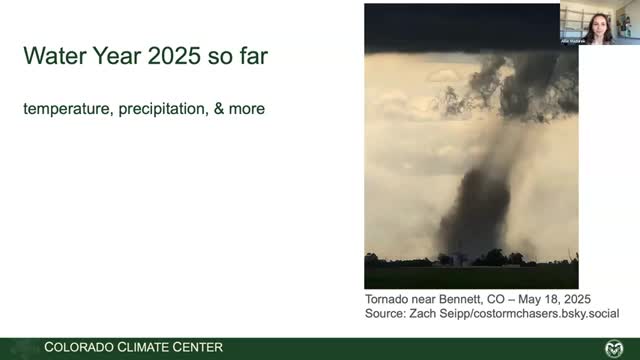Meteorologists report warmest first seven months for Colorado's water year
May 22, 2025 | Natural Resources - Colorado Water Conservation Board, State Agencies, Organizations, Executive, Colorado
Thanks to Scribe from Workplace AI , all articles about Colorado are free for you to enjoy throughout 2025!

This article was created by AI using a video recording of the meeting. It summarizes the key points discussed, but for full details and context, please refer to the video of the full meeting. Link to Full Meeting
The meeting opened with a striking image of a tornado near Denver, a reminder of the unpredictable nature of Colorado's weather. As the discussion shifted to temperature trends, it became clear that this year is tied for the warmest on record, with every month except January showing above-average temperatures. Particularly, the Western Slope and Southern Colorado have experienced widespread warmth, raising concerns about the implications for water supply and agricultural needs.
Precipitation patterns painted a stark contrast to the temperature data. While November brought significant snowfall, it was an anomaly in an otherwise dry season. The last five months have been marked as the fourth driest December through April period on record, with much of the state, especially the Western Slope, facing lower than normal precipitation levels. This trend poses challenges for water management as the state prepares for the summer months.
The committee utilized quadrant charts to illustrate the ongoing conditions, highlighting that Colorado is currently experiencing a climate that is both warmer and drier than the historical averages. This data is crucial for understanding the potential impacts on water availability and ecosystem health as the state moves forward.
As the meeting progressed, members expressed the need for proactive measures to address these changing conditions. The discussions underscored the importance of monitoring and adapting to the evolving climate, ensuring that Colorado's water resources are managed effectively in the face of these challenges. The implications of this year's weather patterns will likely resonate throughout the state, influencing everything from agriculture to water conservation efforts as the summer approaches.
Converted from Water Conditions Monitoring Committee Meeting - May 2025 meeting on May 22, 2025
Link to Full Meeting
Comments
View full meeting
This article is based on a recent meeting—watch the full video and explore the complete transcript for deeper insights into the discussion.
View full meeting